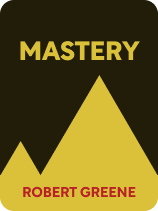

This article is an excerpt from the Shortform book guide to "Mastery" by Robert Greene. Shortform has the world's best summaries and analyses of books you should be reading.
Like this article? Sign up for a free trial here .
What’s the path to excellence? What are the different levels of mastery?
In Mastery, Robert Greene argues that there is a clear path anyone can follow to achieve mastery, the highest level of creative excellence. He explains the three levels of mastery, and he argues that pursuing it yields a fulfilling life and great creative power.
Keep reading to learn about these three levels of mastery.
Levels of Mastery
Attaining mastery is a lifelong process of growth and discovery. Greene explains that you can become a master by persevering through three levels of mastery.
Level #1: Foundational Training
Having established a connection to your inner voice and committed to acting in accord with it, it’s time to pursue your foundational training. Greene explains that all masters undergo a rigorous, self-directed practical education after finishing conventional education in school, which teaches mostly theory. This practical education involves three tasks, which we’ll cover below: learning the ropes of your field, developing key skills, and testing your progress.
(Shortform note: In Black Box Thinking, Matthew Syed argues that practice and theory develop in tandem. That is, people with practical knowledge often innovate without comprehensive theoretical knowledge—think of the Wright brothers creating airplanes through trial-and-error. At the same time, theory often leads to practical advances—for instance, Charles Darwin’s theory of evolution began with an idea, yet it has sparked immense change in science and culture.)
Task #1: Learn the Ropes
Greene explains that in any career field, there are existing rules, norms, and conventions that people follow. Learn these to ensure you can navigate your field and avoid offending people’s sensibilities. There are explicit rules and implicit rules:
- #1: Explicit rules. These are the stated rules and conventions. For instance, a university gives graduate students attendance and performance expectations.
- #2: Implicit rules. These are unspoken rules that govern social and power dynamics. For instance, new graduate students might be expected to defer to older students.
Greene recommends staying inconspicuous when you first enter a field. Patiently learning the ropes teaches you to keep an open mind, set aside your assumptions, and observe before acting which, according to Greene, are key life skills and traits of masters.
| Patient Practice Brings Opportunity In So Good They Can’t Ignore You, Cal Newport echoes Greene’s advice to start by building your skills. Newport advises that you first build skills that give you “career capital”—that is, develop scarce, in-demand skills that afford you access to prized jobs. If you have the right skill set to secure a rewarding, niche job—such as a luthier—then you gain the autonomy and meaning of that prized work. Avoid depending on the supposed truism that matching your passion and your work will bring you fulfillment—that’s not usually true, Newport asserts. Instead, take on the mindset of a craftsperson: Focus on what you bring to the table, and work continually to hone those skills. The better you get, the more opportunities will open to you. Once you’ve developed a highly valuable, scarce skill set—such as proficiency in an emerging coding language—you have leverage to negotiate with your employer for increased autonomy. Newport describes autonomy as the “dream-job elixir,” and he contends that it will make you happier and more productive at work, since you’re more in control of what you do. |
Task #2: Develop Your Skills
Alongside your observation, begin to train your technical abilities. Every field has its skills, and you’ll need technical proficiency to achieve mastery. Greene recommends starting with one skill that underpins others in your field. For example, an aspiring novelist could learn to brainstorm and organize her thoughts before trying more complex aspects of creative writing.
Task #3: Test Your Progress
Once you’ve acclimated to your field and built your skills, Greene recommends seeking feedback by demonstrating what you’ve learned. To do this, take on some responsibility at work—such as a project or an initiative with which you can test your progress.
Begin to test your progress before you feel ready. When you publicly test your skills, you’ll gain objective feedback from your peers and superiors. Avoid taking it personally—feedback isn’t strictly supportive, so remain objective and improve the weaknesses that it reveals.
(Shortform note: In Thanks For the Feedback, Douglas Stone and Sheila Heen explain that learning to receive feedback well helps you learn and grow, while resisting feedback causes problems and stagnation. We often react instinctively to feedback, and such strong emotions can get in the way of learning. To overcome this, the authors recommend becoming mindful of how you react and separating your emotions from the objective content of the feedback.)
Level #2: Creative Independence
Once you’ve completed your foundational training, it’s time to step out into the world. In this section, we’ll explain the second level of mastery: creative independence.
In this level of mastery, you begin to pursue your own inclinations. You’ve built a solid foundation of skills and knowledge, and you can now apply them to develop your ideas—whether you want to explore a new form of art or a scientific theory. In doing so, you’ll gain recognition and start to make a name for yourself.
To achieve creative independence, Greene advises that you avoid becoming rigid. After years of foundational training, you might settle into learned conventions and familiar ways of thinking that reduce your creativity. Prevent this stagnation by taking the three steps to cultivate a creative mind: Commit to a creative project, pursue it to fruition, and persist through emotional obstacles.
| Curate Your Influences In Steal Like An Artist, Austin Kleon suggests amplifying your creativity by surrounding yourself with art that you love. In his view, there’s no such thing as a wholly original idea—all artists are influenced by others. While this may seem unfortunate, Kleon recommends embracing that you don’t need to be original, and you can instead focus on what you love. To curate your influences, fill your studio or workspace with art from artists that inspire you—records, paintings, posters, music, or whatever else. Further, Kleon suggests copying the work of artists you love to learn how they created it and practice your technique. For instance, you might deep-dive into the portfolio of your favorite painter, studying her work and figuring out how she does it. Then, what you’ve learned will enrich your own process and repertoire of techniques. |
Level #3: Mastery
After spending years developing your creative independence, you’ll eventually achieve mastery. According to Greene, mastery comes about when you merge rational thinking with sophisticated intuition—using your experience and learned skills as well as your openness and intuition to explore novel ideas and thoroughly work them out.
However, Greene argues, Western culture often fails to recognize this powerful combination because it esteems rationality above other forms of thinking and mythologizes high-level intuition:
- Rational thinking involves laying out the steps you took—showing your work so that others can scrutinize your process and conclusions. We consider this valid thinking because it’s easy to show how you got from A → B and replicate the process.
- However, high-level creative insights can’t be explained so easily. They depend on complex, nonlinear intuition and lack clear steps from A → B. As a result, people attribute such insights to mystical forces like genius or talent.
| Intuition Is Fallible In Thinking, Fast and Slow, Daniel Kahneman argues that we have two cognitive systems: System 1 represents quick, intuitive judgments, and System 2 represents slow, deliberative reasoning. This model mirrors Greene’s articulation of how masters create—they use both the instinctive snap decisions of System 1 and the meticulous reasoning of System 2. However, Kahneman emphasizes that these systems are prone to error. System 1 functions on heuristics—that is, it references known patterns and solutions to help us make judgments, but these often shortcut the full complexity of a situation. If System 2 uncritically accepts System 1’s input, you’re likely to err. Keep this in mind, and try to reason through your ideas when you’ve had plenty of rest—stress makes System 2 more prone to biased thinking. |
Masters See the “Flow” of Their Fields
Greene argues that with high-level intuition and reason, a master grasps her field as a whole, and she becomes attuned to its “dynamic.” In other words, she sees how the parts fit together and flow as one whole, and she intuitively senses the dynamic, evolving form of it all.
Mastery Is a Lifelong Journey
Greene explains that time and effort inevitably yield mastery—he asserts that it takes around 20,000 hours. In other words, you’ll get there guaranteed if you put in the hours.
However, the time you spend developing mastery must be intense and committed. You can’t just go through the motions, because half-hearted practice yields half-hearted results. Show up with vigor and verve, putting everything you’ve got into your work and taking every opportunity to learn, and you’ll reap far fuller rewards.

———End of Preview———
Like what you just read? Read the rest of the world's best book summary and analysis of Robert Greene's "Mastery" at Shortform .
Here's what you'll find in our full Mastery summary :
- The clear path anyone can follow to achieve mastery
- An explanation of the three stages of mastery
- How learned conventions and familiar ways of thinking reduce creativity






